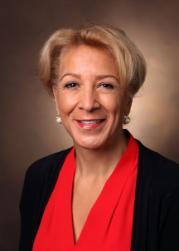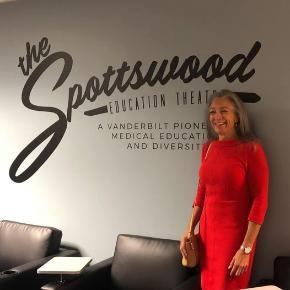Profile of Stephanie Spottswood, M.D., M.S.P.H.
A Leader in Diversity, Equity and Inclusion, Spottswood Creates Opportunity for the Next Generation of Radiologists
 Stephanie Spottswood, M.D., M.S.P.H., F' 92, came to VCU School of Medicine in the 1990s to complete a pediatric radiology fellowship. She stayed on as faculty for several years before bringing her expertise in pediatric radiology to the Eastern Virginia Medical School (EVMS). After two years at EVMS, she was recruited to the Monroe Carell Jr. Children’s Hospital at Vanderbilt to practice pediatric radiology and serve as the Chief of Pediatric Nuclear Medicine, and later, to serve as the Department of Radiology’s first Associate Vice Chair for Diversity, Equity and Inclusion (DEI).
Stephanie Spottswood, M.D., M.S.P.H., F' 92, came to VCU School of Medicine in the 1990s to complete a pediatric radiology fellowship. She stayed on as faculty for several years before bringing her expertise in pediatric radiology to the Eastern Virginia Medical School (EVMS). After two years at EVMS, she was recruited to the Monroe Carell Jr. Children’s Hospital at Vanderbilt to practice pediatric radiology and serve as the Chief of Pediatric Nuclear Medicine, and later, to serve as the Department of Radiology’s first Associate Vice Chair for Diversity, Equity and Inclusion (DEI).
Spottswood is intelligent, ambitious and deliberate, and from early on, she was poised for success. In addition to advancing her knowledge of pediatric radiology, she made it her mission to improve access for women and underrepresented minorities in radiology.
Spottswood, now retired and an Emerita Professor of Radiology at Vanderbilt University, continues to mentor women and inspire leaders of DEI across the country.
Creating Opportunities for Women
While at VCU, Spottswood joined Wendy Klein, M.D., in developing a career development program for women. The idea of the program initially came from Klein and “what many people don't know is that in the early 1990s, we started this program at VCU School of Medicine because we saw an alarming discrepancy and disparity between women and men in the upper ranks of medicine,” adds Spottswood.
Women received the same exceptional clinical training as men but there was not yet a foundation in place to support the career development of women. Spottswood says, “Women just did not seem to be getting promoted at the same rate as men. Women were not aware of the promotion and tenure guidelines. Our goal was to address the disparities that deterred and disadvantaged women. As I was learning my way, I wanted to help women avoid the kind of mistakes and pitfalls I found myself maneuvering during my career.” Spottswood’s involvement in the career development program for women was pivotal and with the encouragement of her mentors, she learned what she needed to do to succeed.
Career Investments Pay Lifetime of Dividends
In 2012, Reed Omary, M.D., M.S., joined the Department of Radiology at Vanderbilt as their new Chair. He was interested in advancing DEI and asked Spottswood to develop a program. She adds, “Since my time in the residency program, about 15 years had passed before another African American resident was admitted to the program. I really embraced this opportunity to make a difference.” In 2013, she became their first Associate Vice Chair for Diversity, Equity and Inclusion. She was responsible for increasing the representation of women and underrepresented minorities in the radiology residency program, promoting DEI among staff and faculty, as well as improving health equity for their diverse patient population.
Spottswood began her research of radiology-specific DEI programs but there weren’t any at that time. Undeterred, Spottswood formed a team and developed a multifaceted DEI program. The intent of the program was to increase the diversity of the applicant pool, and they hoped it would have a secondary effect of increasing the diversity of the radiology residency.
Spottswood says, “We created holistic screening tools for reviewing residency applications and we developed a more diverse recruitment committee. We updated everything from website design and advertisements to giving medical students early access to radiology. We made applicants aware that our department was interested in diversifying itself and we encouraged students to come and take a look at our culture and what we do.”
Within four years, the applicant pool of women and underrepresented minorities increased -- from 7.5 percent to 13 percent for underrepresented minorities. By 2018, the number of enrolled residents also diversified going from zero to 20 percent. In 2019, when the national average of minorities in residency programs was about eight percent representation, Vanderbilt had 25 percent -- five years after the start of the program.
Beyond the data, the real reward of DEI in radiology is that patients and students see themselves in clinicians and faculty. Spottswood says, “Patients who can relate to their physicians because they are the same culture, the same ethnic group, or the same religion are more likely to follow instructions and ask questions. They are more likely to trust and say that they are satisfied with the care.”
Unconscious Bias in Medicine
Unconscious bias, also known as implicit bias, overshadows decisions and actions, and can influence the treatment of patients. A learned attitude or assumption, bias exists in our subconscious. It stems from constant exposure of biased content in news, TV, books, social media and even one’s upbringing.
The medical community has recognized that unconscious bias affects the quality of patient care. Recognized for her expertise in this area, Spottswood speaks on the subject matter both nationally and internationally. “Doctors, nurses, and other health care professionals are exposed to the same types of negative images and stereotypes about certain cultures and ethnic groups. It’s imperative to teach the medical community how our unconscious bias unintentionally forms our beliefs and affects the way we treat people. We are not immune, it affects physicians just like everyone else,” says Spottswood.
The Important Role of Female Leaders in Radiology
Spottswood, through research and surveys, confirmed that the representation of women in the Vanderbilt Department of Radiology was low. Women held only a few leadership positions and they hadn’t achieved the same level of academic success as compared to their male counterparts.
In 2014, Spottswood joined her colleague, Lucy Spalluto, M.D., M.P.H., to develop a program, “Leadership Intervention to Further the Training of Female Faculty (LIFT-OFF) in Radiology.” The purpose of LIFT-OFF was to improve women's access to opportunities for faculty development and career advancement. More importantly, they aimed to improve women’s understanding of expectations and the path of advancement.
After two years, Spottswood and Spalluto evaluated the program’s outcomes and found that 31 percent of female faculty indicated an improved understanding on how to advance into leadership positions. They also found that 52 percent of participants reported that the program improved their access to career advancement opportunities. After five years, several women in the program successfully achieved promotion to new academic ranks and leadership positions.
During the 2021-2022 academic year, women represented 54 percent of residents in the Vanderbilt’s radiology residency program while nationally representation was at 29 percent. Additionally, women secured seven full professors, three vice chairs, three program directors and four section chiefs during the same academic year. Spottswood adds, “It was really nice to see those results and they are important because we helped raise awareness about the path to promotion. We now have women in leadership positions who mentor and guide other women. More of our faculty are fulfilled and thriving and it’s easier to retain our talented staff.”
Their commitment to DEI has garnered national recognition. Other departments at Vanderbilt started emulating the DEI programs, and the medical school updated practices and policies to improve the environment for all medical students. These institution-wide efforts trickle down to patient care. Spottswood is proud of the progress but is aware this is an ongoing effort that isn’t finished yet.
Read her published research on the subject of DEI:
A Leadership Intervention to Further the Training of Female Faculty (LIFT-OFF) in Radiology
Design, Implementation, and Evaluation of a Diversity Program for Radiology
Five Years Later: Impact of a Focused Women in Radiology Program
 For her lifetime of contributions, Spottswood has received numerous awards and honors. She earned several Faculty Achievement Awards from the Vanderbilt University Minority Faculty organization and the Levi Watkins, Jr Faculty Award for her work in diversity and inclusion. In 2016, she received the Margaret Cuninggim Women’s Center Mentoring Award and, in 2017, Spottswood became the inaugural Co-Chair for the Society for Pediatric Radiology’s (SPR) Committee on Diversity and Inclusion. In 2022, after a career of selfless dedication to radiology education, the Vanderbilt Department of Radiology honored Spottswood with the naming of a new medical education center called “The Spottswood Education Theatre.”
For her lifetime of contributions, Spottswood has received numerous awards and honors. She earned several Faculty Achievement Awards from the Vanderbilt University Minority Faculty organization and the Levi Watkins, Jr Faculty Award for her work in diversity and inclusion. In 2016, she received the Margaret Cuninggim Women’s Center Mentoring Award and, in 2017, Spottswood became the inaugural Co-Chair for the Society for Pediatric Radiology’s (SPR) Committee on Diversity and Inclusion. In 2022, after a career of selfless dedication to radiology education, the Vanderbilt Department of Radiology honored Spottswood with the naming of a new medical education center called “The Spottswood Education Theatre.”